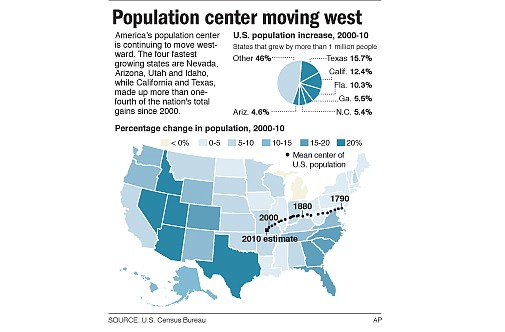WASHINGTON (AP) - America's population center is edging away from the Midwest, pulled by Hispanic growth in the Southwest, according to census figures. The historic shift is changing the nation's politics and even the traditional notion of the country's heartland - long the symbol of mainstream American beliefs and culture.
The West is now home to the four fastest-growing states - Nevada, Arizona, Utah and Idaho - and has surpassed the Midwest in population, according to 2010 figures. California and Texas added to the southwestern population tilt, making up more than one-fourth of the nation's total gains since 2000.
When the Census Bureau announces a new mean center of population next month, geographers believe it will be placed in or around Texas County, Mo., southwest of the present location in Phelps County, Mo. That would put the center at the outer edge of the Midwest, on a path to leave the region by midcentury.
"The geography is clearly shifting, with the West beginning to emerge as America's new heartland," said Robert Lang, a sociology professor at the University of Nevada-Las Vegas who regularly crunches data to determine the nation's center. "It's a pace-setting region that is dominant in population growth but also as a swing point in American politics."
The last time the U.S. center fell outside the Midwest was 1850, in the eastern territory now known as West Virginia. Its later move to the Midwest bolstered the region as the nation's cultural heartland in the 20th century, central to U.S. farming and Rust Belt manufacturing sites.
In the 1960s, "Will it play in Peoria?" was a common phrase that coincided with the U.S. center's location in Illinois. It was a measure of whether a politician or consumer product could appeal to mainstream Americans with traits associated with Midwesterners, such as stability and caution.
But over the last decade, the Phoenix suburb of Peoria, Ariz., soared past its namesake Peoria, Ill., in population size. Democrat Barack Obama in 2008 successfully made the Republican-leaning Mountain West a key component to winning election, with Colorado, Nevada and New Mexico now considered swing states.
With Arizona on track to surpass Ohio in electoral votes by midcentury, based on projected growth, issues important to the West, such as Arizona's sharp debate over immigration, gain in political significance.
The Census Bureau calculates the mean U.S. center every 10 years based on its national head count. The center represents the middle point of the nation's population distribution - the geographic point at which the country would balance if each of its 308.7 million residents weighed the same.
The latest 2010 figures show a loss of House seats for states including Missouri and those east of it, primarily in the Midwest's declining Rust Belt. Eight of the 12 pickups in House seats occur in states west of Missouri, with Florida, Georgia and South Carolina in the southeastern Sun Belt being the exceptions.
The fastest U.S. growth is occurring in the Mountain West, which includes Arizona, Colorado, Idaho, Montana, Nevada, New Mexico, Utah and Wyoming. As California's growth slows, many of the Mountain state arrivals are Hispanic immigrants seeking jobs and affordable family living. Hispanics tend to lean Democratic when voting.
Historically, the first center of population in 1790 resided in Kent County, Md., 23 miles east of Baltimore, the fulcrum between Pennsylvania and New York in the North and slave states in the South. It moved west through West Virginia amid the rise of steamboat travel and development of the nation's first railroads in the 1820s.
The U.S. center stayed put in Indiana from 1890-1940, largely stalled by a wave of European immigrants to the Northeast and then the Great Depression. It made big strides in Illinois in the 1950s as California boomed and Alaska and Hawaii gained statehood, before taking on a southwesterly path.
Missouri has been at the U.S. center since 1980.
State officials are tentatively planning for a commemorative marker in Texas County or its vicinity. Texas County boasts 26,000 residents, with whites making up 92 percent of the population, compared with roughly 65 percent for the country. Blacks make up 3.3 percent and Hispanics 1.6 percent.
"I think it's appropriate that people in the county get some recognition," said Brad Gentry, 48, of Houston, Mo., who publishes the weekly paper in Texas County. "It's primarily agriculture, and we have a lot of retirees. Despite a high rate of poverty, people are resilient and make things work - even if they are pretty disillusioned by the political process that has bogged down Washington."

